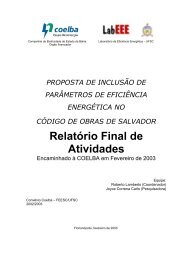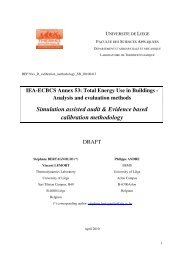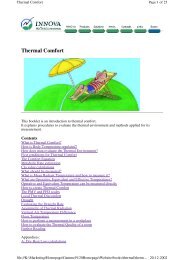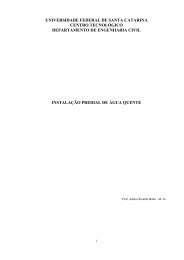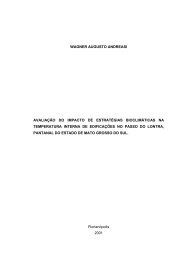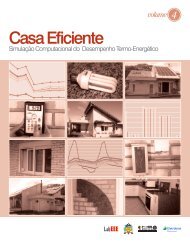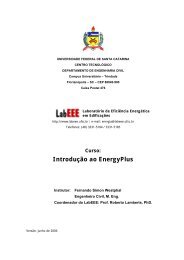ASHRAE STANDARD - 55R
ASHRAE STANDARD - 55R
ASHRAE STANDARD - 55R
You also want an ePaper? Increase the reach of your titles
YUMPU automatically turns print PDFs into web optimized ePapers that Google loves.
BSR/<strong>ASHRAE</strong> Standard 55P, Thermal Environmental Conditions for Human Occupancy 2/24/03<br />
Third Public Review Draft (Independent Substantive Changes to the Second Public Review)<br />
For the purposes of Section 5, the thermal environment is defined with respect to the occupant.<br />
Air temperature is the average temperature of the air surrounding an occupant. The average is with<br />
respect to location and time. As a minimum, the spatial average is the numerical average of the air<br />
temperature at the ankle level, the waist level and the head level. These levels are 0.1 m, 0.6 m and 1.1<br />
m (4 in., 24 in. and 43 in.) respectively for seated occupants and 0.1 m, 1.1 m and 1.7 m (4 in., 43 in. and<br />
67 in.) for standing occupants. Intermediate, equally spaced locations may also be included in the average.<br />
When the occupant is in a directed airflow, the air temperature on the upstream side should be used. As a<br />
minimum, the temporal average is a three-minute average with at least 18 equally spaced points in time.<br />
However, the period may extend up to 15 minutes to average cyclic fluctuations if necessary. The<br />
temporal average applies to all locations in the spatial average.<br />
Local air temperature is defined in the same way as the air temperature except that it refers to a single<br />
level (e.g. head level). At least one location is required at this level. However, multiple locations<br />
around the body may be included to determine a better average.<br />
Mean radiant temperature is defined as the temperature of a uniform, black enclosure that exchanges<br />
the same amount of thermal radiation with the occupant as the actual enclosure. It is a single value for<br />
the entire body and may be considered a spatial average of the temperature of surfaces surrounding the<br />
occupant weighted by their view factors with respect to the occupant. See Chapter 8 in the, 2001 1997<br />
<strong>ASHRAE</strong> Handbook--Fundamentals 3 for a more complete description of mean radiant temperature. For<br />
the purpose of Section 5, mean radiant temperature is also a time-averaged value. As a minimum, the<br />
temporal average is a three-minute average with at least 18 equally spaced points in time. However, the<br />
period may extend up to 15 minutes to average cyclic fluctuations if necessary.<br />
Operative temperature is the average of the air temperature and the mean radiant temperature<br />
weighted respectively by the convection heat transfer coefficient and the linearized radiation heat<br />
transfer coefficient for the occupant. See Chapter 8 in the, 2001 1997 <strong>ASHRAE</strong> Handbook--<br />
Fundamentals 3 for a more complete description of operative temperature. For occupants engaged in<br />
near sedentary physical activity (with metabolic rates between 1.0 met and 1.3 met), not in direct<br />
sunlight, and not exposed to air velocities greater than 0.20 m/s (40 fpm), the relationship can be<br />
approximated with acceptable accuracy by<br />
to = (ta + tr) / 2<br />
where<br />
to is the operative temperature,<br />
ta is the air temperature, and<br />
tr is the mean radiant temperature.<br />
Radiant asymmetry is the difference between the plane radiant temperature in opposite directions. The<br />
plane radiant temperature is defined similarly to mean radiant temperature except that it is with respect<br />
to a small planar surface element exposed to the thermal radiation from surfaces from one side of that<br />
plane. The vertical radiant asymmetry is with plane radiant temperatures in the upward and downward<br />
direction. The horizontal radiant asymmetry is the maximum difference between opposite plane radiant<br />
temperatures for all horizontal directions. The radiant asymmetry is determined at the waist level, 0.6 m<br />
23



